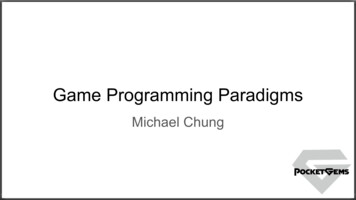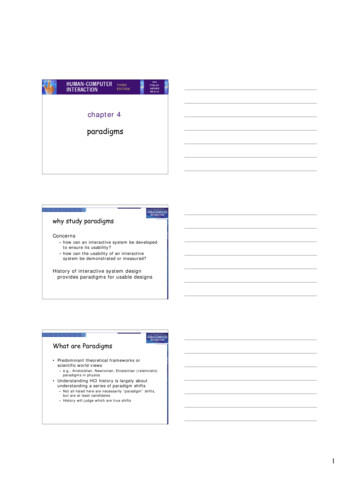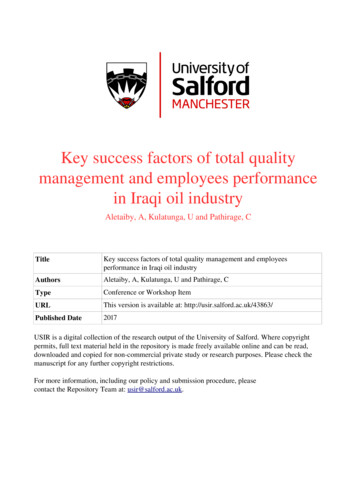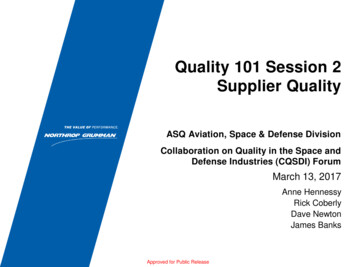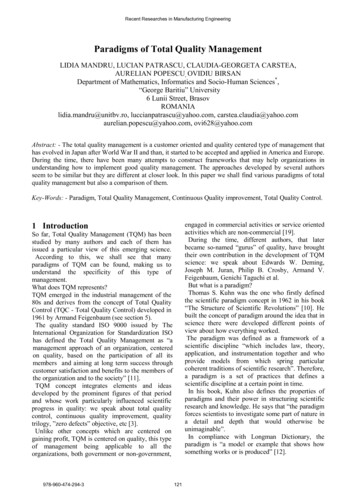
Transcription
Recent Researches in Manufacturing EngineeringParadigms of Total Quality ManagementLIDIA MANDRU, LUCIAN PATRASCU, CLAUDIA-GEORGETA CARSTEA,AURELIAN POPESCU, OVIDIU BIRSANDepartment of Mathematics, Informatics and Socio-Human Sciences*,“George Baritiu” University6 Lunii Street, BrasovROMANIAlidia.mandru@unitbv.ro, luccianpatrascu@yahoo.com, m, ovi628@yahoo.comAbstract: - The total quality management is a customer oriented and quality centered type of management thathas evolved in Japan after World War II and than, it started to be accepted and applied in America and Europe.During the time, there have been many attempts to construct frameworks that may help organizations inunderstanding how to implement good quality management. The approaches developed by several authorsseem to be similar but they are different at closer look. In this paper we shall find various paradigms of totalquality management but also a comparison of them.Key-Words: - Paradigm, Total Quality Management, Continuous Quality improvement, Total Quality Control.engaged in commercial activities or service orientedactivities which are non-commercial [19].During the time, different authors, that laterbecame so-named “gurus” of quality, have broughttheir own contribution in the development of TQMscience: we speak about Edwards W. Deming,Joseph M. Juran, Philip B. Crosby, Armand V.Feigenbaum, Genichi Taguchi et al.But what is a paradigm?Thomas S. Kuhn was the one who firstly definedthe scientific paradigm concept in 1962 in his book“The Structure of Scientific Revolutions” [10]. Hebuilt the concept of paradigm around the idea that inscience there were developed different points ofview about how everything worked.The paradigm was defined as a framework of ascientific discipline “which includes law, theory,application, and instrumentation together and whoprovide models from which spring particularcoherent traditions of scientific research”. Therefore,a paradigm is a set of practices that defines ascientific discipline at a certain point in time.In his book, Kuhn also defines the properties ofparadigms and their power in structuring scientificresearch and knowledge. He says that “the paradigmforces scientists to investigate some part of nature ina detail and depth that would otherwise beunimaginable”.In compliance with Longman Dictionary, theparadigm is “a model or example that shows howsomething works or is produced” [12].1 IntroductionSo far, Total Quality Management (TQM) has beenstudied by many authors and each of them hasissued a particular view of this emerging science.According to this, we shall see that manyparadigms of TQM can be found, making us tounderstand the specificity of this type ofmanagement.What does TQM represents?TQM emerged in the industrial management of the80s and derives from the concept of Total QualityControl (TQC - Total Quality Control) developed in1961 by Armand Feigenbaum (see section 5).The quality standard ISO 9000 issued by TheInternational Organization for Standardization ISOhas defined the Total Quality Management as “amanagement approach of an organization, centeredon quality, based on the participation of all itsmembers and aiming at long term success throughcustomer satisfaction and benefits to the members ofthe organization and to the society” [11].TQM concept integrates elements and ideasdeveloped by the prominent figures of that periodand whose work particularly influenced scientificprogress in quality: we speak about total qualitycontrol, continuous quality improvement, qualitytrilogy, ”zero defects” objective, etc [3].Unlike other concepts which are centered ongaining profit, TQM is centered on quality, this typeof management being applicable to all theorganizations, both government or non-government,978-960-474-294-3121
Recent Researches in Manufacturing EngineeringIn the following analyze, we shall discoverdifferent models of TQM developed during the timeby specialists who tried to find a clear way in thislabyrinth.effectively for the company.9. Break down barriers between departments.People must work as a team.10. Eliminate slogans, exhortations and targets forthe work force asking for zero defects and newlevels of productivity (they create adversarialrelationships).11. Eliminate work standards (quotas) on the factoryfloor. Eliminate management by numbers,numerical goals. Substitute leadership.12. Remove barriers that rob workers of pride ofworkmanship.13. Institute a vigorous plan of education and selfimprovement.14. Put everybody in the company to work toaccomplish the transformation. Transformationis everybody’s job.The 14 points may be applied in any organization,either small or large, operating in the serviceindustry as well as manufacturing; they apply to adivision of a company [5].2 Edwards W. DemingE. W. Deming worked as a statistician in WesternElectric Company, USA and he is often called “thefather of the Quality Management movement”. Histeachings were considered to have a leadinginfluence in the revival of the Japanese economyafter World War II. In the ‘80s major corporations inthe USA and other countries began to put in practicehis management theory.As Deming said, quality should be checked at eachstep of a process not by inspecting the product orservice once it is completed. In his vision the mostquality problems regarding the product or servicesupplied result from faults in management ratherthan from the carelessness of workers; he believedthat people do their best and it is the system thatmust change to improve quality [8], [19].For Deming, quality represents “a predictabledegree of uniformity and dependability at low costand suited to the market” [6]; from his point of view“quality should be aimed at needs of the consumer”[5].The modern paradigm of quality control can bebest summarized in the 14 interrelated points thatformed the basis for Deming advice in helping thetop management to improve the organization’sperformances regarding quality [8, 21, 15, 5, 14, 1]:1. Createconstancyofpurposetowardimprovement of product and service with the aimto become competitive, to stay in business and toprovide jobs.2. Adopt the new philosophy: we can no longer livewith commonly accepted levels of delays,mistakes, defective workmanship.3. Cease dependence on mass inspection to achievequality; require instead statistical evidence thatquality is built in.4. End the practice of awarding business on thebasis of price tag; instead minimize total cost.5. Find problems. It is management’s job toimprove constantly and forever the system ofproduction and service, to improve quality andproductivity and thus constantly decrease costs.6. Institute training on the job.7. Institute leadership. The aim of leadership is tohelp people, machine and gadgets to do a betterjob.8. Drive out fear so that everyone may work978-960-474-294-33 Joseph M. JuranJ. M. Juran was an American professor byRomanian origin who joined Western ElectricCompany and developed Western Electric StatisticalQuality Control Handbook. Together with Deming,Juran contributed to Japanese organizations successin the 50’s and 60’s [19, 15]. Juran was the one whopromoted the concept known as Managing BusinessProcess Quality which is a technique for executingcross-functional quality improvement [16]. Hebecame well-known for his quality trilogy thatimplies planning, control and quality improvement.He defined quality as “fitness for use”,characterized by the bellow mentioned features [19]:- Quality of design: through market research,product and concept.- Quality of conformance: through management,manpower and technology.- Availability: through reliability, maintainabilityand logistic support.- Full service: through promptness, competenceand integrity.Juran established that ten steps have to be followedfor continuous quality improvement (see box 1).Juran used a variety of statistical methods thatunderpin “the ten steps”; like Deming, he studiedunder W. Shewhart and thus shares many of thesame approaches, for example control charts. Oneof the best known is Pareto analysis that Juran usedin order to separate ‘the vital few’ problems from‘the useful many’ [22].122
Recent Researches in Manufacturing EngineeringOn the basis of the four absolutes of quality,Crosby built the 14-steps roadmap for qualityimprovement in an organization [14, 15]:1. Make it clear that management is committed toquality.2. Set up quality improvement teams withrepresentatives from each department.3. Measure processes to determine where currentand potential quality problems lie.4. Evaluate the cost of quality and explain its useas a management tool.5. Raise the quality awareness and personalconcern of every employee.6. Take actions to correct problems identifiedthrough previous steps.7. Establish a committee for the “zero defects”program.8. Educate and train supervisors on their roles andresponsibilities in the quality improvementprocess.9. Hold a ‘zero defects day’ to show everyonethere has been a change and to reaffirmmanagement commitment.10. Encourage individuals to establish improvementgoals for themselves and their groups.11. Encourage employees to communicate tomanagement the obstacles they face in attainingtheir improvement goals.12. Recognize and appreciate those who participatein quality improvement.13. Establish quality councils to discuss qualitymatters on a regular basis.14. Do it all over again and emphasize that thequality improvement process never ends.Crosby is the one who introduced the concept of“zero defects” stating that things should be doneright the first time and every time. He stressesmotivation and planning and does not dwell onstatistical process control and the several problemssolving techniques of Deming and Juran: he statesthat ‘quality is free’ because the small costs ofprevention shall always be lower than costs ofdetection, correction and failure [16]. In his vision,senior management is 100% responsible for theproblem of quality and its continuance rather thanemployees [19, 3].Box 1 Juran’s Ten Steps Roadmap forcontinuous quality improvement [23, 15, 19]1. Build awareness of the need and opportunityfor quality improvement.2. Set goals for continuous improvement.3. Organize to reach the goals (establish a qualitycouncil, identify problems, select projects,appoint teams, designate facilitators).4. Provide training.5. Carry out projects to solve problems.6. Report progress.7. Show recognition.8. Communicate results.9. Keep a record of successes.10. Incorporate annual improvements into thecompany’s regular system and processes.Over the long term, Juran’s contribution may begreater than Deming’s because Juran has thebroader concept while Deming’s focus on statisticalprocess control is more technical oriented [16].4 Philip B. CrosbyCrosby was the Vice President and the QualityDirector of International Telephone & Telegraph(ITT) [15, 19]. According to Crosby, qualityrepresents “conformance to requirements” and thatfor he states that it is necessary to translaterequirements into measurable product or servicecharacteristics. This is possible by using numericalspecifications that enables one to quantify thecharacteristics of a product (e.g.: diameter of a hole)or service (e.g.: customer service response time)showing thus the quality level [14].One of the main Crosby’s contributions was a setof four absolutes of quality which are relevant forTQM (see table 1) [19, 15]:Table 1 Crosby’s Four Absolutes of QualityAbsolute ymeasurement978-960-474-294-3DescriptionQuality is conformance torequirements, nothing moreor less and certainly notgoodness or elegance.Prevention not appraisal.“Zero defects” not somethingclose to it.Price of non-conformance(how much the defects costthe company).5 Armand V. FeigenbaumFeigenbaum was a mathematician, the president ofAmerican Society of Quality Control (1961-1963)and founding chairman of the InternationalAcademy for Quality. He defined quality as [15]:- “The total composite product and servicecharacteristics of marketing, engineering,123
Recent Researches in Manufacturing Engineeringregression analysis, cumulative curve probabilitygraphs, Taguchi experiments, etc.manufacture and maintenance through which theproduct and service in use will meet theexpectations of the customer” and- “Best for the customer use and selling price”.Feigenbaum points of view reflect a systemicattitude of mind: if we have a closer look at thesecond definition of quality we find two constraintsthat have not previously been seen: ‘customer use’and ‘selling price’. The first one may not differ fromDeming’s “needs of the consumer” or Crosby’s“conformance to requirements” but it suggests aconstraint rather than an ideal to aim for. It seems toimply that, perhaps, there are limits to useful quality[2].Feigenbaum was the one who coined the phrase“Total Quality Control” and thus he broadened thequality control into a holistic concept that includesall aspects of a business (the concept is known inJapan as Company Wide Quality Control) [9]. Heexplains the Total Quality Control as follows: theunderlying principle of the total quality view and itsbasic difference from all other concepts is that inorder to provide genuine effectiveness, control muststart with identification of customer qualityrequirements and end only when the product hasbeen placed in the hands of a customer whoremained satisfied.Feigenbaum has developed ‘Ten Benchmarks ofTotal Quality Control for the 1990’s’ as shownbellow (see box 2):6 Genichi TaguchiTaguchi was a telecom engineer who spent much ofhis professional life to improve the quality ofmanufactured products [17]. Among the Japaneseapproaches to quality, Taguchi methods have beenthe most widely adopted in America and Europe [1].In the 80’s, he had a great contribution in the qualitymovement by eliminating the need for massinspection through the process of buildi
Box 1 Juran’s Ten Steps Roadmap for continuous quality improvement [23, 15, 19] improvement in an organization [14, 15]: 1. Build awareness of the need and opportunity for quality improvement. 2. Set goals for continuous improvement. 3. Organize to reach the goals (establish a quality council, identify problems, select projects,
